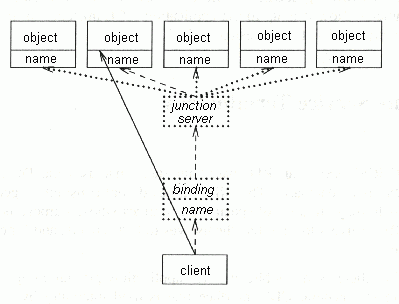
The following figure illustrates the principle of junctions. A junction server, which is reached normally through binding information in the DCE namespace, maintains its own namespace of named objects. The junction server's clients allow users to refer to these objects by actually concatenating the server's entry name and an object's internal name. The client then in effect breaks this string apart by contacting the server named in the first part of the string, and passing to it the second part, which is a valid name within the server's namespace. The client's user seems to access the object directly.
A Namespace Junction

The dashed lines in this figure show the progress of the client's efforts to get access to the desired object, which involves acquiring a binding to the junction server, making contact with it, and passing to it the object's name. The solid line shows the apparent direct access to the object that the client's user seems to enjoy. The dotted lines show other possible paths of access to the other objects that the server manages.
Junction protocol is generally a private matter between an application's clients and servers. However, the acl_edit command uses a generalized protocol.